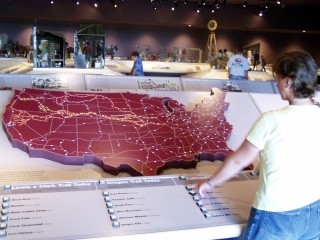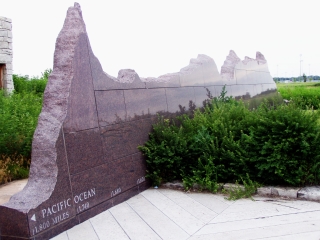Western Historic Trails Center
Council Bluffs, Iowa
Visited: June 30, 2004
NPS Site Visited: Not an NPS Site
Local Website
 WHAT IS IT? WHAT IS IT?
An NPS-affiliated site that commemorates the four cross-country trails that both began and/or passed through or around Council Bluffs, Iowa: the California Trail, the Lewis and Clark Trail, the Mormon Trail and the Oregon Trail.
BEAUTY (3/10)
The Centerís entranceway is striking. You exit the highway and immediately turn onto a long one-way road made all the more narrow by steep tall-grass sprouting along its edges. We think it is safe to say that we exceeded the speed limit driving through this cool prairie tunnel. The pathway from the parking lot to the museum is paved with bricks etched with the names of the many people and many Indian tribes and nations involved in the story of the American West.
To the right of the path is an impressively horizontal granite sculpture whose right edge reads the Mississippi River and left the Pacific Ocean. Mile markers are notched and the sculpture rises and falls with the changes in altitude moving east to west. The gradual climb of the Great Plains to the sharp ascent of the Rockies to the rapid decline where the Trails meet the Pacific Ocean. We sure have a long way to go.
The Museum doubles as an Iowa Welcome Information Center and the building plays the part well. Non-descript would be generous. The museumís interior design is confusing and detracts from the learning experience. We had a great deal of trouble figuring out which way to go.
HISTORIC SIGNIFICANCE (6/10)
Historically, Americans have traveled for many reasons. Religious freedom (Mormon Trails), economic promise (California Trail), discovery (Lewis and Clark) and a new life (Oregon Trail). It is easy for any traveler to understand the history of the Trails.
CROWDS (3/10)
There were a surprisingly large number of people at the Site, perhaps because of the proximity to the highway, maybe due to the 200th anniversary of the Lewis and Clark Trail. We had difficulty viewing the exhibits. There were always many people in front of them.
EASE OF USE/ACCESS (5/5)
Just off Exit 1-B on Interstate 80 in Council Bluffs, Iowa. As a Welcome Center, the ease of access is almost a given.
CONCESSIONS/BOOKSTORE (4/5)
Lots of books, lots of Lewis and Clark stuff and lots of Iowa knickknacks. Despite the large selection, the storeís organization was lacking and much of the merchandise was hidden away in the roomís corners.
COSTS (4/5)
The Site is free.
RANGER/GUIDE TO TOURIST RATIO (1/5)
No Rangers, just an Iowa Welcome woman working the desk, asking people to sign the registry book.
 TOURS/CLASSES (4/10) TOURS/CLASSES (4/10)
The Museumís thesis is interesting, evocative and one that has appeared on our website already: the transient nature of Americans and the oneness todayís travelers share with those of the past. The interactive light-bulb map is the first thing tourists see. The map not only lights up the historical trail routes, but also highlights the modern day Interstates. We found it amazing, but completely believable, that our roads faithfully follow the traditional routes.
The film stresses the same concept by interspersing quotes, still pictures and videos of all eras. One hears a Lewis and Clark quote about packing foodstuffs while watching a modern-day family load a Volkswagen minivan to the gills. The video is an abstract adventure that neither has a center nor explains anything at all. What did the video teach us about the historical trails? Nothing. We learned that we have a lot in common with the past, a point much better demonstrated by the electric map.
Two exhibit panels rise above the jumbled nature of the rest, a trails timeline located behind the map and a right to left (very confusing until you realize itís meant to go east to west) journey along the trails, situated in the back of the museum.
FUN (4/10)
If you have a National Parks Passport Book, the Center has five, yes five, stamps for your book. We were so giddy about the stamp bounty and subsequently unable to concentrate that we had to return to the Site a few days later. Our return was disappointing. In our short first time stay we had already seen the best parts of the museum, the brick pathway, the granite sculpture and the electric map. The film, the remainder of the museum and even the well-stocked bookstore were all under whelming at best. Once was enough.
WOULD WE RECOMMEND? (4/10)
If your journey across country involves Interstate 80, the Western Historic Trails Center is not a bad place to stop. It could frame your visit historically; you are just following tradition.
Even if you are not a quixotic NPS passport stamp collector, the Site has handy National Park Trail maps for the four trails discussed.
TOTAL 38/80
|